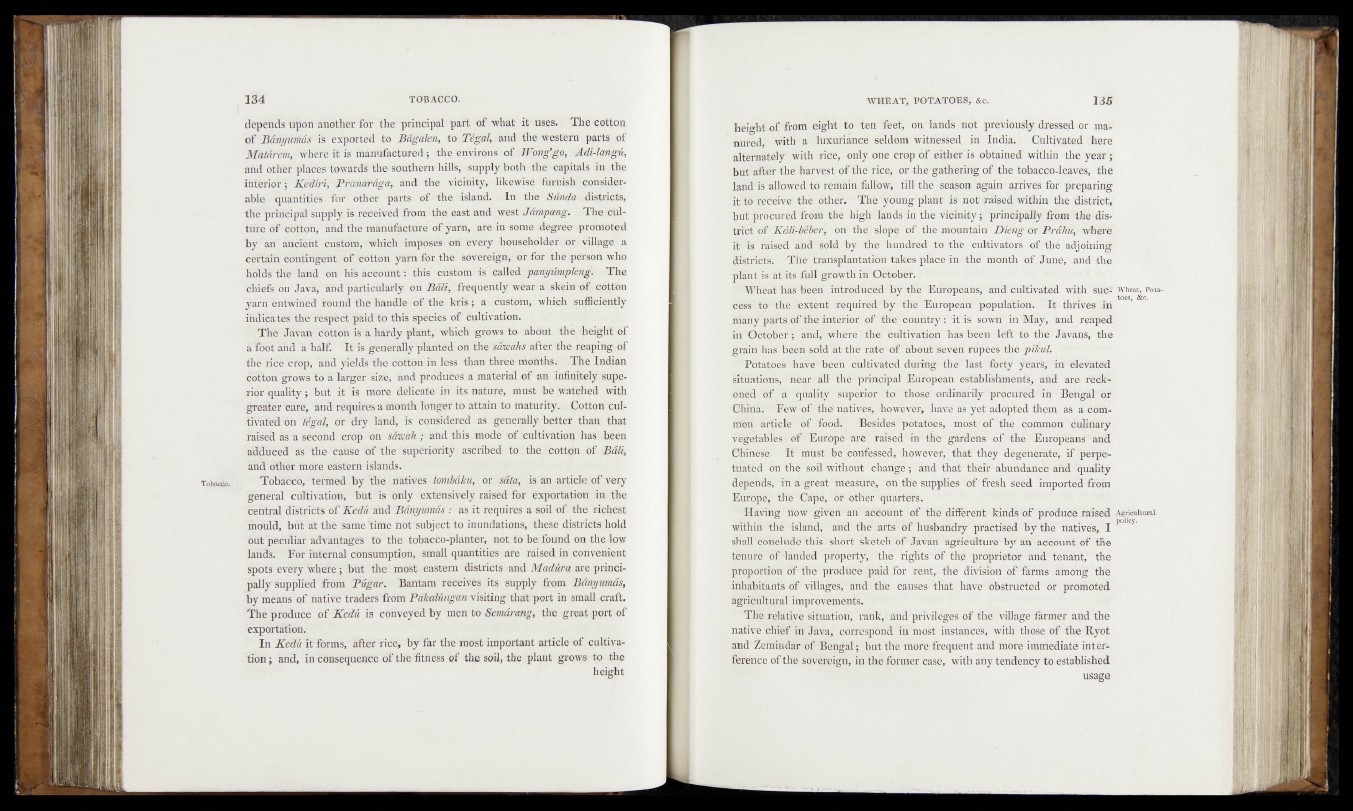
depends tijpoti another for the principal part of what it ilsesi The cotton
of Bahyiirfids is exported to Bdgakn, to Tegdl, and the western parts of
Matdrem, where it is manufactured; the environs of Wong’go, Adi-lang-u,
and other places towards the Southern hills, supply both the capitals in the
ihteriot; Kediri, Ptanardga, and the vicinity, likewise furnish considerable
quantities for other parts of the island. »„In the Sunda districts,
the principal Supply, is received from the east and west -Jampang. The ctd-
tore of cotton, and the manufacture of yarn, are in some 'degree promoted
By an ancient custotln, Which iftiposes on every householder - or village a
certain contingent Of cotton yarn for the sovereign, •or fbr the person who
holds the land on'his account: this custom is called panyumpleng- The
fchiefs on Java, and particularly on Bali, frequently wear a skein of cotton
yarn enfwihed roUnd the handle Of the kris ; a custom, which sufficiently
indicates the respect paid to this species of cultivation.
. The Javan cotton is a Mfdy plant, which groWs to abdut the height of
a 'foot and a half.' ‘It is geiiefrally planted oh the sawahs -after the reaping of
•the rice crop, and yields'the cotton in less than three months. The Indian
Colton gtows to a larger sizte, and produces a material of an infinitely superior
quality; but it is more delicate in its nature, must be watched with
greater -eare, and rhquifesa month longer to attain to maturity—gotten cul-
ttvated^on legal, or dry land, is considered as generally better than that
raised as a second crop 'On sawah ; ahd this "mode *of ‘cultivation has been
adduced as the cause 'of the nuperidrity ascribed to. the eotfcgn of Bali,
and other mo're e&sterfi isla’nds.
Tobaojio, Tobacco, 'terffied by fhe natives tdmbaku, or' sola, is an artjele'of very
general cuTtivatidn, l>iit is only 'extensively raised for exportation in the
central districts of !Ked& ahd B d n yum d sas it requires a soil of- the ribhest
mould, but at the same 'time hot subject to inundations, these district hold
out peculiar advantage's to the tobacco-planter, not to be found on the -low
lands. For internal eohstfmptlon, small quantities are raised-in convenient
spots eV¥ry where; but the most eastern -districts and Madfrra are principally
supplied lo in Pugar. Bantam receives its supply from Bdm/imds,
by meanS of rih'tive ’traders from PdktiMngan visiting that port in small craft.
The produce of Xedd is conveyed by men to Semdrmg, the great port of
exportation.
In Kedh it fbrms, stffer rice, by ’far the most important article of cultivation
j and, in consequence of thfe fitness of the seSl, the plant grows to -the
height
height of-from eight to ten feet, on lands» not previously dressed or manured,
With a 'luxuriance -seldom -witnessed in' India. Chltjvgted here
alternately with rieé; only one crop óf either1 is obtained' within the
but after the-harvest of thé^ricé,* or the gathering of the tobacco-leaves, thé
land is allowed tó rëm’ain fallow, till the seasorjt again arrives for preparing
it tó'Lrëéëive the -other. The'-yohng plaht is not'raised -within the district,
but procured from the high lands in the "vicinity ; principally from the district
of Kdlft-beber, 'on the - slope of the übómrifcam PHéng ör 'Prahu, Where
it is raised and sold by the1 -hundred to the cultivators’’ of ttre adjoining
districts. ' 'Thé' transplantation -takes place in the nionth of June, and the
plant is aFfts .full growth in October. -
Wheat has -been introduced by the Europeans, and cultivated with MÜ wheat, Pota-
I H ■ R ■ i'i. . . : - . -n- ja J , toes, &e. cess td 1 -iie!lextent required by the European population. It thrives ini
hiaiïy-parts of the interior Óf‘ the1 country •: it is sown in Maÿ, -and rehpid
in'October; and, where1 the cultivation -hâa'bèe'h- left to the” Jàvans, thé
grain-has-'béëh Sold ât the rate o’f about "seven rupees-the piMul.
Potatoes have-“beeh cultivated, during the lasf^ffirfc/'yëaïi^n 'elevated
situations, near all the principal European establishments, and are reçkl-
oUed bY"''' a "quality superior-to1 those-" ordinarily*'procured in Beh'gal'ö?
China. Few of'dB bnatjv'éil,’- %o wé vél,- havé •as’’yet adopted them ds a coidi
mon article!eof'j food. Besides -potatoes, most of the common émiriàfy .
óf'TSutope- 'arts'1 raised^ ih” tne: gardens' o fr th é ; Europeans1 ''and
Chinese.'1 mu^t1 be'Confessed,'•"'hswev’fei', that they degenerate, if 'perpetuated
on the soil without change ; and that thei'r abundance and quality
dépends, in a great measure, on the supplies- of-fresh seed importée!-front
Eufbpe, the -Cape, ÖF otHeri quarters.
‘‘Having1 now given an-account of the different kinds of produce raised Agricultural
policy. Within the island, and the arts of husbandry practised-by the natives,- !
ha®w6'diicffi’d^'l',this1 Ish'ort 'sketch of Javan -agriculture ^ ^ " a c c p u n f ' of the
tëhùre of 'lantiëd property, the rights of thp proprietor and* Tenant,' thé
proportion oft the produCe paid for • .rent,. the' division of Tarais' lEmon§^th'e
inhabitants of villages, and thd‘ causes that have obstructed'or promoted
agricultural improvements.
The relative Situation, rank, and privileges 6Ÿ tne: village farmer andHhe
native chief in Java, correspond in móst 'instances; with those of the Ryot
and Zemindar of Bengal ; but the mor'e-freqUent and more immediate interference
of the sovereign, in the former case,, with any-tendency to established
usage